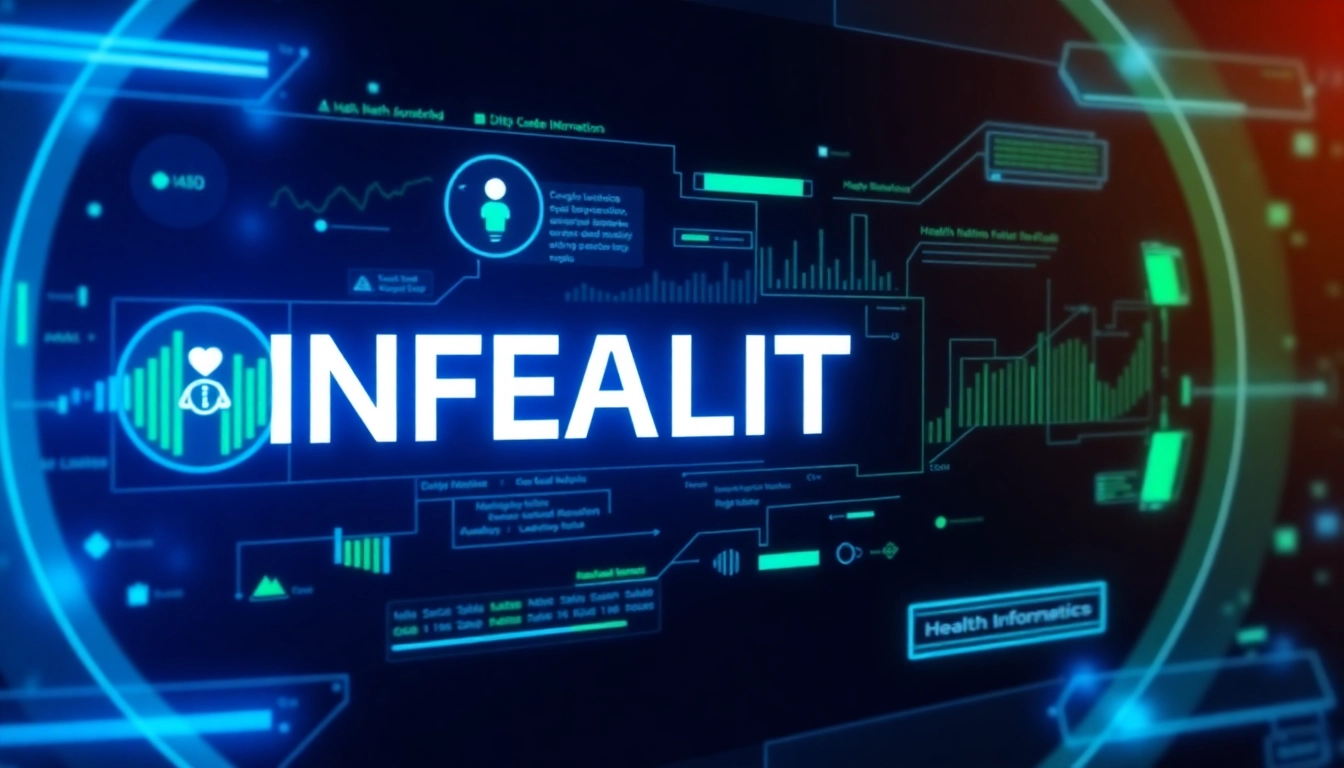Understanding Informatics and Its Importance
In the digital age, the term “informatics” has emerged as a pivotal concept that impacts a variety of fields, most notably healthcare. But what exactly does it entail? Simply put, informaticsview.com defines informatics as the study and practice of creating, storing, finding, manipulating, and sharing information. This multifaceted discipline intertwines technology and data to enhance the human experience, particularly in improving healthcare delivery. In this article, we will delve into the essence of informatics, its application in healthcare, the technologies that propel it forward, and explore how it addresses many contemporary challenges.
Defining Informatics in Modern Context
The realm of informatics encompasses several branches, including health informatics, bioinformatics, and social informatics, each with unique focuses and applications. Broadly, informatics deals with converting raw data into meaningful information through sophisticated data processing systems. As society becomes increasingly data-driven, the relevance and impact of informatics continue to grow. This is essential not only for academic research but also for industries where quick, data-informed decisions are crucial.
Informatics is fundamentally about the flow of information: how it is collected, managed, and disseminated. It combines expertise from multiple fields, including computer science, health care, and information technology, to formulate solutions that enhance our interactions with data. In healthcare, this includes but is not limited to the management of Electronic Health Records (EHRs), clinical decision support systems, and telemedicine technologies.
The Role of Informatics in Healthcare
At the intersection of technology and healthcare lies health informatics—a subdomain of informatics that focuses on how data can be utilized to improve patient care. The increasing integration of EHRs in medical practices has revolutionized the way clinicians document and share patient information. Health informatics not only allows for more accurate record-keeping but also facilitates a holistic approach to patient care by providing healthcare providers with comprehensive data about their patients’ health histories.
Moreover, the American Medical Informatics Association (AMIA) asserts that informatics improves healthcare outcomes by optimizing the management of data in clinical environments. This discipline aids healthcare professionals in making informed decisions, thus enhancing the quality of care while reducing costs. Informatics plays a crucial role in areas such as predictive analytics, public health tracking, and disease management, demonstrating its versatility and significance in modern healthcare frameworks.
Key Technologies Behind Effective Informatics
As healthcare adopts more technological solutions, several key innovations in informatics are expanding its potential. These include:
- Artificial Intelligence (AI): AI algorithms analyze vast datasets to identify patterns, predict patient outcomes, and even assist in diagnostic and treatment processes.
- Machine Learning: A subset of AI, machine learning enables systems to learn from data and improve their performance over time without explicit programming.
- Blockchain Technology: In the context of healthcare, blockchain can enhance data security, integrity, and accessibility, providing a decentralized means of recording transactions related to patient records.
- Natural Language Processing (NLP): NLP helps in extracting meaningful insights from unstructured data, such as clinical notes, allowing for improved administrative efficiencies and clinical outcomes.
These technologies contribute to the evolution of healthcare informatics, making data more actionable and accessible, ultimately leading to enhanced patient care.
Applications of Informatics in Healthcare
The applications of informatics in healthcare are vast and transformative, significantly impacting both healthcare providers and patients. Let’s examine some of the key applications in detail.
Electronic Health Records: A Case Study
Electronic Health Records (EHRs) are perhaps the most prominent example of informatics in action. They provide a digital version of a patient’s paper chart, making it easier for healthcare providers to access and share patient information securely and efficiently. A case study in a large urban hospital demonstrated that the implementation of EHR systems reduced medication errors by over 30% by streamlining the prescription process and facilitating medication reconciliation. EHRs also improve the speed of patient care by allowing various departments within the hospital to access a single source of truth in real-time.
Furthermore, EHRs contribute to significant cost savings in administration and clinical processes. By automating appointment scheduling, billing, and reporting, these systems enhance operational efficiency, allowing healthcare professionals to devote more time to patient care rather than administrative tasks.
Clinical Decision Support Systems in Practice
Clinical Decision Support Systems (CDSS) leverage health informatics to provide healthcare practitioners with tailored insights related to patient care. By analyzing data from EHRs and other sources, CDSS can alert physicians to potential issues, such as drug interactions or missed diagnoses, effectively enhancing decision-making. One notable implementation at a community hospital led to an 18% reduction in unnecessary imaging tests because of real-time recommendations provided during patient assessments.
Additionally, CDSS fosters adherence to clinical guidelines, ensuring that healthcare providers are updating their practices in line with the latest evidence. This guidance helps maintain high standards of patient care and reduces the variance in treatment decisions among practitioners.
Telemedicine and Remote Patient Monitoring
Telemedicine and remote patient monitoring have emerged as vital components of modern healthcare systems, especially in the wake of the COVID-19 pandemic. These informatics applications allow healthcare providers to deliver care remotely, ensuring that patients continue to receive necessary treatments without the barriers of travel or exposure to illness.
Remote patient monitoring technologies, which often employ connected devices such as wearables, facilitate the continuous tracking of patient health metrics (e.g., heart rate, glucose levels). Data collected through these systems can be communicated directly to healthcare providers for timely interventions. A leading use case involved patients with chronic conditions, where remote monitoring reduced the need for emergency visits by over 25%, demonstrating substantial potential for managing ongoing care.
Challenges in Implementing Informatics Solutions
While the benefits of informatics in healthcare are clear, several challenges can impede successful implementation. Understanding these challenges is critical for proper management and resolution.
Data Privacy and Security Concerns
As healthcare systems increasingly rely on data, the potential for data breaches and misuse becomes a pressing concern. HIPAA regulations set forth strict guidelines for safeguarding patient information, yet breaches continue to occur. Organizations must regularly update their security protocols and training practices to mitigate risks. Healthcare providers could implement strategies such as robust encryption, regular security audits, and employee training programs focused on data handling to minimize vulnerabilities.
Interoperability Issues Between Systems
Another major challenge is the lack of interoperability among different health information systems. Data silos can prevent the seamless flow of information between healthcare entities, leading to fragmented care. The adoption of standardized protocols for data exchange—such as HL7 and FHIR—can encourage greater compatibility between systems, but this requires concerted efforts from both technology vendors and healthcare organizations.
Training and Adoption Barriers
Successful integration of informatics solutions necessitates adequate training for healthcare providers and staff. Resistance to change can be commonplace, particularly in organizations where long-established practices are deeply ingrained. To ensure smoother transitions, leadership should cultivate a culture of continuous learning and adaptation, offering ongoing educational resources and support to encourage staff engagement with new systems.
Best Practices for Successful Informatics Integration
To fully benefit from informatics solutions, healthcare organizations should adhere to best practices that streamline integration and maximize effectiveness.
Steps for a Seamless Transition
Transitioning to new informatics systems requires detailed planning. Initial steps should include assessing the current workflow to identify gaps and needs, formulating a comprehensive implementation plan, and establishing a timeline. Involving key stakeholders—including clinicians, IT staff, and administrative personnel—early in the planning process fosters a sense of ownership and aligns efforts toward common goals.
Measuring Success and Impact
Organizations should employ specific metrics to assess the impact of informatics initiatives. Key performance indicators (KPIs) might include reductions in error rates, improvement in patient satisfaction scores, and changes in operational efficiency. By establishing benchmarks prior to implementation, organizations can track progress and identify areas for improvement effectively.
Continual Learning and Adaptation Strategies
The rapidly evolving nature of technology necessitates continual learning. Healthcare organizations must establish ongoing education and adaptability strategies that encourage staff to stay current with technological advancements and evolving best practices. This could involve regular training sessions, knowledge-sharing meetings, and a dedicated support team available to assist with ongoing challenges.
Future Trends in Informatics
As health informatics continues to evolve, several future trends are likely to shape its trajectory in healthcare settings.
AI and Machine Learning Insights
AI and machine learning will undoubtedly lead the way in future informatics advancements. From predictive analytics that identify patients at risk of developing chronic diseases to algorithms that personalize treatment plans based on extensive patient data, the impact of AI on healthcare is profound. Organizations can harness these technologies to enhance diagnostic accuracy, optimize operations, and ultimately improve patient outcomes.
The Rise of Predictive Analytics in Patient Care
Predictive analytics is becoming increasingly significant in patient care through its ability to forecast patient needs based on historical data and trends. Utilizing large datasets, healthcare practitioners can foresee complications and take proactive measures. This approach helps in managing patient populations more effectively and curtailing the rise of chronic diseases before they become more challenging and costly to treat.
Crowdsourcing and Collaborative Informatics
Lastly, collaborative informatics, augmented by crowdsourcing strategies, is gaining traction as a means of harnessing collective intelligence for enhanced decision-making in healthcare. By pooling data and insights from diverse sources, healthcare organizations can foster innovation and make more informed choices based on varied perspectives. This collaborative approach could catalyze significant advancements in public health initiatives, clinical research, and patient education.



